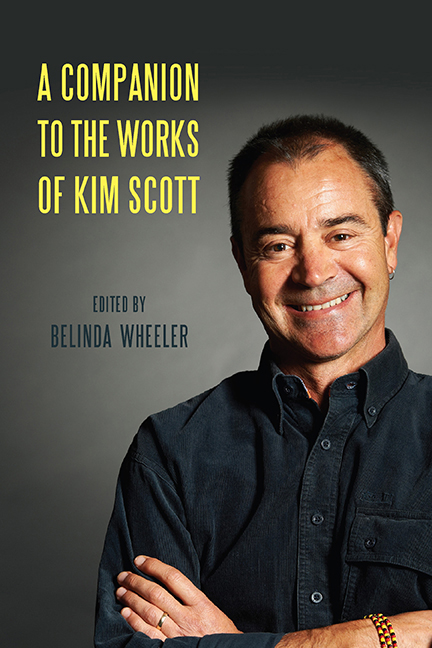Book contents
- Frontmatter
- Contents
- Foreword
- Acknowledgments
- Note on Orthography
- Chronology of Key Writings
- Introduction
- 1 Kim Scott’s Publishing History in Three Contexts: Australian Aboriginal, National, and International
- 2 Kim Scott’s True Country as Aboriginal Bildungsroman
- 3 The Land Holds All Things: Kim Scott’s Benang—A Guide to Postcolonial Spatiality
- 4 Kim Scott’s Kayang and Me: Noongar Identity and Evidence of Connection to Country
- 5 “Wreck/Con/Silly/Nation”: Mimicry, Strategic Essentialism, and the “Friendly Frontier” in Kim Scott’s That Deadman Dance
- 6 The International Reception of Kim Scott’s Works: A Case Study Featuring Benang
- 7 Traumatic Landscapes: Inscribing Spectrality and Identity in Kim Scott’s “A Refreshing Sleep,” “Capture,” and “An Intimate Act”
- 8 Spatial Poetics and the Uses of Ekphrasis in Kim Scott’s “Into the Light” and Other Stories
- 9 The Poetry of Kim Scott
- 10 The Wirlomin Project and Kim Scott: Empowering Regional Narratives in a Globalized World of Literature
- 11 Kim Scott as Boundary Rider: Exploring Possibilities and New Frontiers in Aboriginal Health
- 12 An Interview with Kim Scott
- Notes on the Contributors
- Index
1 - Kim Scott’s Publishing History in Three Contexts: Australian Aboriginal, National, and International
Published online by Cambridge University Press: 08 May 2021
- Frontmatter
- Contents
- Foreword
- Acknowledgments
- Note on Orthography
- Chronology of Key Writings
- Introduction
- 1 Kim Scott’s Publishing History in Three Contexts: Australian Aboriginal, National, and International
- 2 Kim Scott’s True Country as Aboriginal Bildungsroman
- 3 The Land Holds All Things: Kim Scott’s Benang—A Guide to Postcolonial Spatiality
- 4 Kim Scott’s Kayang and Me: Noongar Identity and Evidence of Connection to Country
- 5 “Wreck/Con/Silly/Nation”: Mimicry, Strategic Essentialism, and the “Friendly Frontier” in Kim Scott’s That Deadman Dance
- 6 The International Reception of Kim Scott’s Works: A Case Study Featuring Benang
- 7 Traumatic Landscapes: Inscribing Spectrality and Identity in Kim Scott’s “A Refreshing Sleep,” “Capture,” and “An Intimate Act”
- 8 Spatial Poetics and the Uses of Ekphrasis in Kim Scott’s “Into the Light” and Other Stories
- 9 The Poetry of Kim Scott
- 10 The Wirlomin Project and Kim Scott: Empowering Regional Narratives in a Globalized World of Literature
- 11 Kim Scott as Boundary Rider: Exploring Possibilities and New Frontiers in Aboriginal Health
- 12 An Interview with Kim Scott
- Notes on the Contributors
- Index
Summary
IN ORDER TO BETTER UNDERSTAND and appreciate Kim Scott's publishing history, it is important to first place it in the context of the publishing history of Australian Aboriginal literature. Only then can one properly situate it in the larger context of Australian literature. Finally, for full effect, Scott's publishing history should be placed in the context of the international literary marketplace.
Scholars have already performed a valuable service by sketching the high points in the publishing history of Australian Aboriginal literature. For example, it is generally agreed that the first Australian Aboriginal writer to have a book published was David Unaipon (Munro, 150). His collection of myths, Native Legends, was published in 1929. Scholars of Australian Aboriginal literature jump ahead nearly forty years, however, before they land upon another book they deem noteworthy—Kath Walker's first book of poetry, which was published in 1964 (Munro, 151). Indeed, as Anita M. Heiss writes in her seminal book on the subject, Dhuuluu-Yala—To Talk Straight: Publishing Indigenous Literature (2003), “Aboriginal written literature did not fully develop into a distinct genre until the 1970s, 80s and 90s” (25).
A lot has been made of the 1980s, in particular, as a highlight and turning point in the publishing history of Australian Aboriginal literature. For example, Heiss and Peter Minter write, “Mainstream publishers … took a strong interest in Aboriginal authors, and by the end of the 1980s Aboriginal writing was firmly established as a major force in Australian letters” (6). The “end of the 1980s” is significant because it was also the lead-up to the 1988 Australian bicentennial celebrations. Oliver Haag echoes this sentiment in a chapter on the subject of Australian Aboriginal autobiographies and biographies: “From tentative beginnings between the 1950s and the 1970s, they saw tremendous growth during the 1980s and 1990s” (5).
Scott's early publishing history aligns perfectly with scholarly observations about this trend, since his writing career began in 1985 and had already begun to gain some momentum by the end of the 1980s when his poems were being reprinted in various anthologies. Between 1985 and 1987, Scott published four poems—first in a little-remembered journal titled Patterns and then in the Fremantle Arts Review, which had subsumed Patterns as a regular feature.
- Type
- Chapter
- Information
- A Companion to the Works of Kim Scott , pp. 9 - 24Publisher: Boydell & BrewerPrint publication year: 2016



